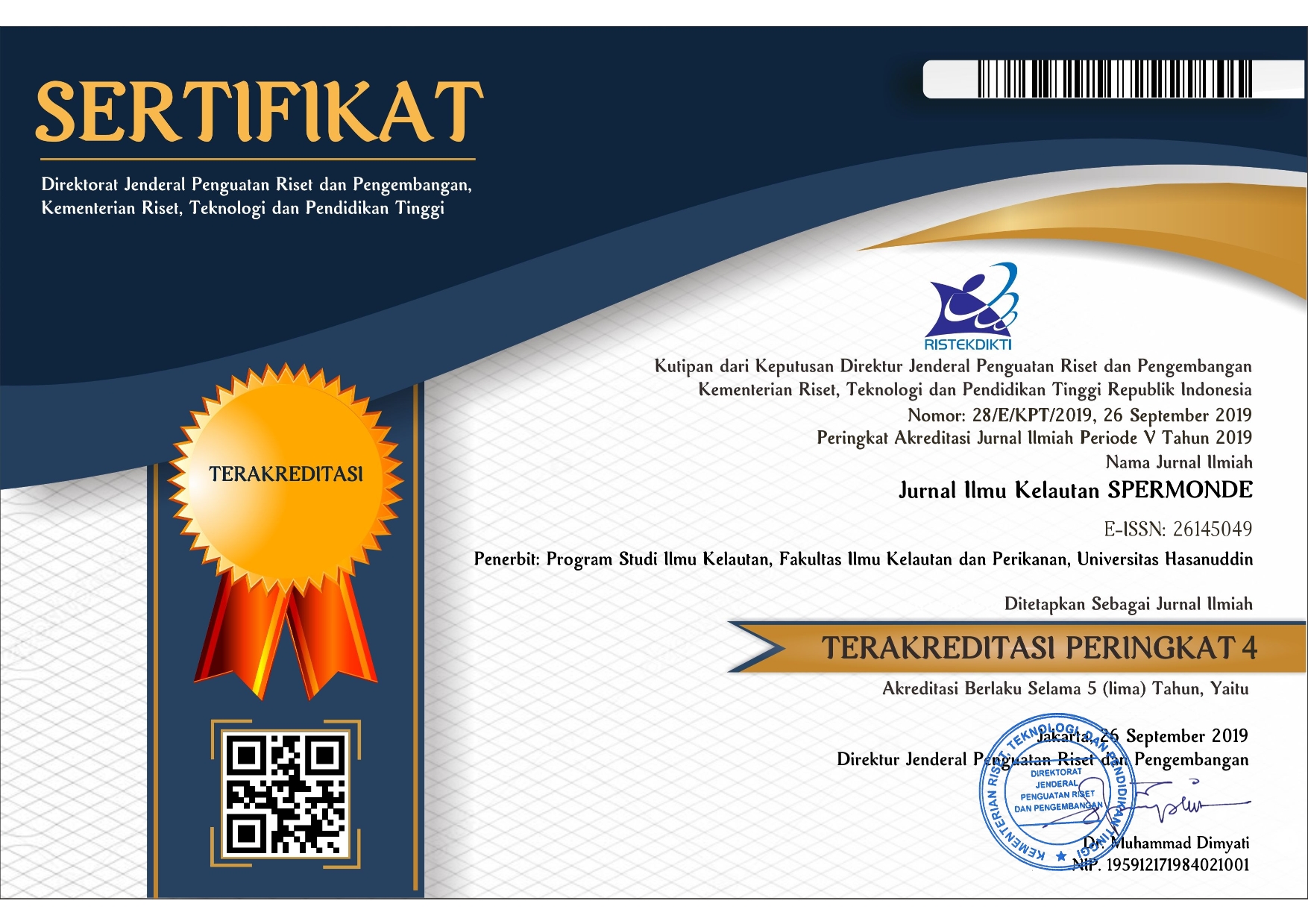SOME CHARACTERISTICS OF ATMOSPHERIC BOUNDARY LAYER OVER MAKASSAR
DOI:
https://doi.org/10.20956/jiks.v4i1.3797Keywords:
atmospheric boundary layer, atmospheric stability, AERMET, boundary layer heightAbstract
Some upper air atmospheric parameters measured during period of 2011-2016 by means of radiosonde located at Hasanuddin International Airport were examined for characterization of boundary layer over Makassar, Indonesia. These data, combined with surface atmospheric parameters were used to calculate some boundary layer parameters using AERMET model which based on Monin-Obukhov similarity theory. The obtained Monin-Obukhov length which reflecting atmospheric stability then converted into traditional Pasquill-Gifford stability classification. Examination of wind characteristics of wind showing clearly their dependence of the day, season and height. Winds dominantly flows from the southeast during the daytime with the relatively larger velocity and from the northwest with smaller velocity during the nighttime. Interpretation of monin-obukhov length using Pasquill-Gifford stability classification showing that the atmosphere was dominantly unstable during the daytime and dominantly stable during the nighttime. These atmospheric stabilities were also varied during seasons. The height of convective boundary layer (CBL) was start to rise in the morning and reaching its maximum in the afternoon (18:00) at the mean value of 2 km. Meanwhile, the height of mechanical boundary layer (MBL) during the day time forming parabolic curve with its maximum value of 1.2 km at noon. These indicated that any released pollution from the stack will be less dispersed during the nighttime due to the fact of lower mixing height, lower wind speed, atmosphere become more stable, and it dispersed in different direction compare to the daytime.Downloads
References
Assegaf, AH. and Jayadipraja EA, Modeling of CO Dispersion from Tonasa Cement Factory Stack Using AERMOD Model, in Physics National Seminar: Makassar 2015, Makassar, Indonesia, Faculty of Mathematics and Natural Sciences, Hasanuddin University, (2015) (in Bahasa Indonesia).
Cimorelli, A. J, Steven G.Perry, Akula Venkatram, Jeffrey C.Weil, Robert J.Paine, Robert B.Wilson, Russell F.Lee, Warren D.Peters, Roger W.Brode, 2005: AERMOD: A Dispersion Model for Industrial Source Application. Part I: General Model Formulation and Boundary Layer Characterization, Journal of Applied Meteorology 44, 682-693.
Grell, G. A., J. Dudhia and D. R. Stauffer, 1994: A Description of the fifth generation Penn State/ NCAR mesoscale model (MM5), NCAR Tech Note, NCAR/TN-398+STR, 117.
Holtslag A.A.M. and van Ulden A.P. (1983). A simple scheme for daytime estimates of the surface fluxes from routine weather data. J. Clim. Appl. Meteorol. 22, 517–529.
Holtslag A.A.M. and de Bruin H.A.R. (1988). Applied Modeling of the Nighttime Surface Energy Balance over Land. J. Appl. Meteorol. 27, 689–704.
Jayadipraja EA, Daud A, Assegaf AH, Maming. Applying Spatial Analysis Tools in Public Health: The Use of AERMOD in Modeling the Emission Dispersion of SO2 and NO2 to Identify Exposed Area to Health Risks. Public Health of Indonesia 2016;2(1): 20-27.
Jesse L. Thé, Russell Lee, Roger W. Brode (2011): Worldwide Data Quality Effects on PBL Short-Range Regulatory Air Dispersion Models, Weblakes Environment Consultants Inc.
Monin, A.S. and A.M. Obukhov (1954): Basic laws of turbulent mixing in the surface layer of the atmosphere (English translation by John Miller for Geophysics Research Directorate, AF Cambridge Research Centre, Cambridge, Massachusetts, by the American Meteorological Society), Originally published in Tr. Akad. Nauk SSSR Geophiz. Inst. 24(151):163-187.
Perry, S. G. et. al., 2005: AERMOD: A Dispersion Model for Industrial Source Application. Part II: Model Performance against 17 Field Study Databases, Journal of Applied Meteorology 44, 696-708.
Pelliccioni, A., P. Monti, C. Gariazzo, and G. Leuzzi. “Some Characteristics of Urban Boundary Layer Above Rome, Italy, and Applicability of Monin-Obukhov Similarity.” Environ Fluid Mechanics 12 (2012): 405-428.
Stull, Roland B., 1988; An Introduction to boundary layer meteorology. Published by Kluwer Academic Publishers. The Netherlands.
Stull, Roland B., 2017; Practical Meteorology: An Algebra-based Survey of Atmospheric Science. Department of Earth, Ocean and Atmospheric Sciences. University of British Colombia. Vancouver Canada.
US Environmental Protection Agency, 1998a: AERMOD: Revised Draft – User’s Guide for the AMS/EPA Regulatory Model – AERMOD. Office of Air Quality Planning and Standards, Research Triangle Park, NC.
US Environmental Protection Agency, 1998b: Revised Draft – User’s Guide to the AERMOD Terrain Preprocessor (AERMAP). Office of Air Quality Planning and Standards, Research Triangle Park, NC.
Van Ulden A.P. and Holtslag A.A.M. (1985). Estimation of atmospheric boundary layer parameters for diffusion applications. J. Climate Appl. Meteorol. 24, 1196–1207.
Downloads
Published
Issue
Section
License
Copyright (c) 2018 Jurnal Ilmu Kelautan SPERMONDE

This work is licensed under a Creative Commons Attribution-NonCommercial 4.0 International License.

This work is licensed under a Creative Commons Attribution 4.0 International License










